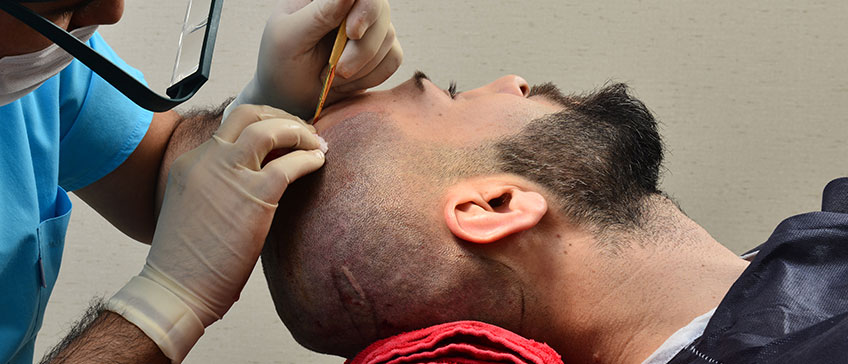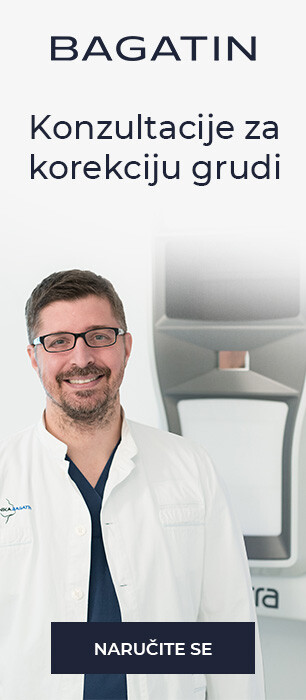The most up-to-date and most effective way to transplant hair is the FUE method. With minimal intervention of special needles, without cuts, stitches and scars, a natural hair appearance and long-lasting effect is achieved.
The procedure is simple, painless and safe, and delivers quality and long-lasting results that make patients extremely happy, with successful hair follicles transplantation of up to 98%. With hair, it’s possible to transplant both eyebrows and beard as well.
About the procedure
FUE (follicular unit extraction) is a minimally invasive method of hair transplantation, in which hair follicles are pulled out with very thin needles from the donor region (places where healthy and lush hair exists) and then individually transplanted to areas where it is necessary to transplant hair. Most often, the follicles are taken from the area behind the ear and the nape of the neck. The patient can go home immediately after the procedure, and after one-week traces of treatment will not be visible at all.
Older methods of transplantation were done by removing entire strips of skin with follicles, so even scars in the form of thick strips were visible, and concealing the scars necessitated wearing longer hair. FUE transplantation is done by taking individual follicles, so the only traces of surgery are invisible or barely visible micro points.
Unlike older methods, this technique provides a completely natural hair look – no difference between natural and transplanted hair, noticeable in older methods.
Hair from transplanted follicles usually falls out ten days after the surgery, thus starting the process of new hair growth. In 3-4 months, the first results will be seen, and after six months to a year, the hair will grow and the patient will again have the original lushness of the hair.
Am I a candidate?
The FUE method is used in both women and men, with different hair loss forms and degrees.
The most common condition remedied by this method is androgenetic alopecia (AGA) for the treatment of male type of baldness, but has also been successfully used with women. This method is also used to help people who have lost their hair due to scalp injuries, burns and the like.
In addition to hair transplantation, eyebrows, eyelashes and beards can also be transplanted with this method.
However, some conditions are not advisable to treat with the FUE method. First of all, this is the case of hair loss in the scalp area in women, then in people who do not have enough donor regions on the scalp, on in patients with keloid scars resulting after injuries or surgeries. Lastly, with hair loss due to medication, such as chemotherapy, doctors usually do not recommend the FUE method.
As with all aesthetic procedures at Bagatin Clinic, the doctor will consider your preferences, health condition and causes of hair loss and give you a specific recommendation after the initial conversation.
How do you prepare?
At the patient’s first visit to the Bagatin Clinic, the doctor will examine the patient, collect all information about his wishes and medical condition, any medication the patient is taking, and make a conclusion about the justification, extent and cost of the hair transplant procedure.
If the transplant is done at a younger age (twenties and thirties and sometimes in the forties), another transplant in 5-10 years is very likely to be required as further hair loss is possible despite successful transplantation.Given that hair loss at the age of 50 has already been strongly defined, the need for another transplant is much less.
The doctor must examine the scalp and inform the client of the possible procedure outcomes with regard to the quantity and quality of the follicles in the donor regions. It is not always possible to fulfill all the client wishes and it is important for the doctor to explain to the client before the procedure, what results can be expected from the transplantation. Sometimes the transplantation is not possible due to the small number of follicles in the donor region, and very young people may be advised to delayed the procedure.
If the doctor believes that the transplantation is possible and the client is satisfied with the intended outcome, we usually give the client a few days to decide about doing the procedure. Once the transplant date has been booked, the doctor will advise against taking some medication (e.g. Andol, Aspirin) and vitamin E. Five days before the procedure, it is important not to consume alcohol, and coffee and tea two days before.
If you are taking any medicine, notify your surgeon, especially if it is a cardiac od psychiatric medication. Persons over 45 years of age are advised to have an ECG examination before accessing the procedure. It is important to smoke as little as possible 24 hours before the procedure.
Before coming to treatment, wash your hair with shampoo and dry it with a clean towel, but avoid gels, sprays and other hair products. Come to the treatment without a wig.
If your appointment is in the morning, you can have breakfast, and if you come in the afternoon, feel free to have a light lunch.
To improve circulation in the receiving region, you can rub Minoxidil 2-10 weeks before the procedure – but be sure to stop two days before the procedure – not required to do so prior to the procedure, but it is mandatory to do so 10 days after the procedure and in the following year, at minimum! You can start using Minoxidil again ten days after the procedure.
At consultations, the doctor will make a complete assessment of the patient’s health status prior to entering treatment and perform the necessary preoperative preparation.
During the procedure
- Before the procedure, the hair is cut in the region from which the follicles will be taken. Most often it is on the back of the head or above the ear. In women, the area that can be covered with longer hair is selected.
- The doctor will apply local anesthesia to the area from which the follicles will be taken. As it is a local anesthesia, the patient is awake and may get up or go to the toilet during the procedure.
- After the donor region has been anesthetized, the doctor will remove a single follicular unit with a special, extremely thin needle, usually with 2-3- follicles (hairs). Because the diameter of the needle is extremely thin (0.8.-1mm), there will be no non-aesthetic scars on the scalp. This part of the procedure lasts approximately three to three and a half hours.
- When all the desired follicles have been removed, treatment is followed to obtain pure follicles, which are then placed on a nutrient medium and in ideal container to preserve them until the time of transplantation.
- The doctor will mark the transplantation positions, define the density, arrangement and implantation direction, to ensure the natural appearance of the hair once the hair is regrown.
- Prior to the start of the last procedure phase, the doctor will apply local anesthesia to the position where the follicles will be implanted.
- The final part of the procedure is the implantation of follicular units. The doctor inserts individual follicles into the first line of the scalp, while multiple follicular units go to other positions.
- Immediately after the procedure, the patient can go home. Bandaging is not needed.
The entire transplant procedure takes 8-9 hours and often takes two consecutive days for a good transplant result.
Recovery time
After treatment, clients may feel pressure or tightness in the scalp, and the forehead may slightly swell. There are normal and harmless side effects that will go away on their own. It is not necessary to use ice.
Recovery from the treatment is very fast, and no signs of transplantation will be visible on the scalp within a week. New hair grows 16 weeks after surgery.
To prevent infections, it is necessary to use an antibiotic and a saline spray to moisten the scalp, every three hours for the first four days after the procedure. It is necessary to apply the spray for two days every three hours at night and later only while you’re awake. The clinic also provides sterile pillow cases, to ensure good hygiene during sleep.
It is advisable not to practice demanding physical activity for several days after the procedure, eat light foods, not drink alcohol day after the procedure, and avoid scratching to prevent infection. After the procedure, rest well and do not turn your head upside down on the procedure day and two days after.
One week after the transplant, you can start with a light workout and after 14 days with a regular routine that may include more intense workouts.
Avoid wearing hair garments and sun exposure for 14 days after surgery – and after 14 days, wear a hat while being exposed to the sun. Burns can have a very negative impact on recovery, so avoid sunburn for two months after surgery.
Wash your hair as advised by the doctor.
Adherence to the doctor’s instructions and good hygiene ensure optimal results and a quick recovery.
The check-up is due in a month.
Precautions
Side effects associated with the FUE hair transplantation are extremely rare and almost exclusively associated with an infection that can occur due to inconsistent use of hygiene precautions. But these are transient and mild side effects such as infections, swelling or scabies.
Most unwanted complications can be prevented by proper care and hygiene.
Free online consultation with our doctors
Send enquiryFeel free to contact us
By phone on +385 1 46 10 225 or through our online contact form
Send enquiry
Locations
| Green Gold Tower Ul. Grada Vukovara 269a/10, 10000 Zagreb |
|
| Donji grad Frana Folnegovića 1c/1, 10000 Zagreb |
|
| Dioklecijan Hotel & Residence Kranjčevićeva 45/1, 21000 Split |
Where to park
| Parking available in Green Gold centre, Zagreb underground garage. For detailed information download a map |

